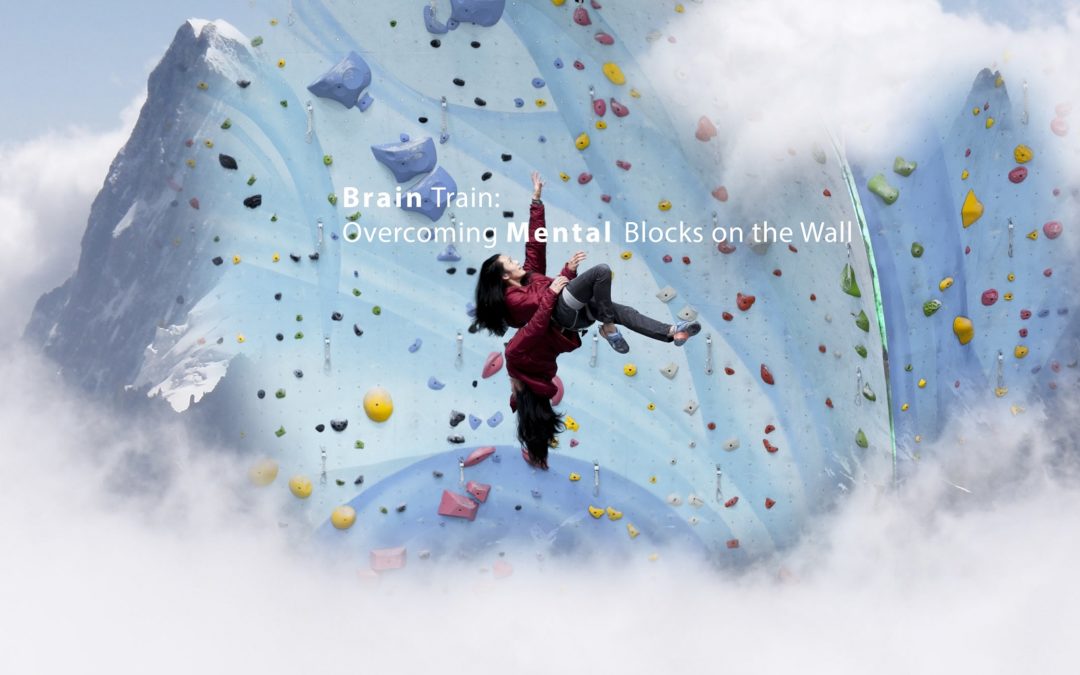Words by Lauren Irvine
“It’s all in your head.”
Sound familiar? It’s a mantra every climber repeats at some point, and usually not in the most comfortable of positions: death gripping, sweaty palms, scrabbling feet, shaky arms. Unless you’re Alex Honnold, you’ve probably found yourself defeated not by a difficult move, but by the mental mettle needed to commit to it.
Whatever your demotivator is--falling, injury, self-doubt--once the haze of fear descends, it’s hard to maintain the focus needed to push through it. And when you’re on the wall facing that fight-flight-or-freeze reflex, your brain realizes that it only has one option: freeze. That means that all the adrenaline dumped into your body by that triggering event has nowhere to go, leaving you hanging there for (what feels like) dear life as your arms rapidly pump out--not exactly the best scenario for logic and rationality to make a comeback!
But it’s not impossible! Gym training is the perfect opportunity to face your fears head on in a safe environment where risks are definitely more perceived than real (although, as always, be sure to follow proper climbing safety guidelines and etiquette). Here are five methods for pushing through the paralysis and getting your mind back on track for the send:
Think different. Spend some time actually analyzing your climbing to identify your strengths and weaknesses. Talk to your climbing partners or gym buddies to get an honest third-party perspective on your movement, body positioning, and efficiency. With a solid idea of where exactly you excel, you can develop a more effective training program to address those problem areas that are unconsciously contributing to your lack of confidence.
Paint yourself a picture. We all find ourselves at the bottom of a route miming the movement sequences with our arms. Turn it into a positive, confidence-building ritual: instead of just waving your arms around, visualize yourself clearly setting up and executing each move. Think about how you can do it as opposed to obsessing over the sketchier moves.
Drill it in. Dedicate some of your warmup time to concentrating on those weaknesses instead of just autopiloting your way up easy routes. You don’t have to work at your level--just consciously choose your warmup routes or problems based on a skill you need to improve, such as balance-heavy slab footwork or dynamic mantle moves. Then, drill yourself on it. The familiarity will translate to your projects.
Safely confront your fear, over and over again. If a long fall above a clip or off a boulder topout is what makes you hesitate, use your gym sessions as an opportunity to train your brain as well as your body. By taking control over falls, you can conquer the terror that comes with the anticipation of empty air. Just do this for one route or a couple boulder problems per session--too much more at once will fry your nerves.
Get on an easier lead route, climb to and clip the third bolt, and immediately take a controlled fall. (Note: let your belayer know what you’re planning to do before you get on the wall, but don’t forget to call “Falling!”) Repeat climbing, clipping, and falling up to the finishing clips. This automatic action will help you cut off the “Don’t fall, don’t fall, don’t fall” loop that can often plague our thoughts on the wall. As you get accustomed to falling safely, take controlled falls on routes closer to and then at your grade.
Similarly, take controlled falls off the bouldering wall. Keep climbing higher and letting yourself drop, taking care to fall and land safely--don’t do your best sack-of-potatoes impersonation.
Prove it to yourself. The worst-case scenarios always happen when you’re on your big project. You reach the crux way more pumped than anticipated, or you’re gassing out because that bouldery section was more muscley than you recalled, and suddenly you’re five feet above your last clip and a committing move on a tenuous hold is between you and the next bolt. It’s the perfect storm of circumstances for that full-body fear to take hold. If you’re getting close to an outdoor excursion or are getting really close on your latest project, head off this potential success-killer at the pass by (safely) putting yourself in that situation. Near the end of a training session, try a harder route when you’re almost maxed out and commit yourself to three attempts to get through the crux. Your own ability may surprise yourself.
In the end, climbing really is just a big game of mind over matter. Train your brain just as you strain your muscles in every climbing session, and your concentration and confidence will continue to increase right alongside your grade.
*Disclaimer: Sender One Climbing is not responsible for any injuries sustained during this training exercise. Use this article at your own discretion. Falls are inherently dangerous, and should be practiced in a controlled environment. Please be considerate of other climbers during all exercises.

